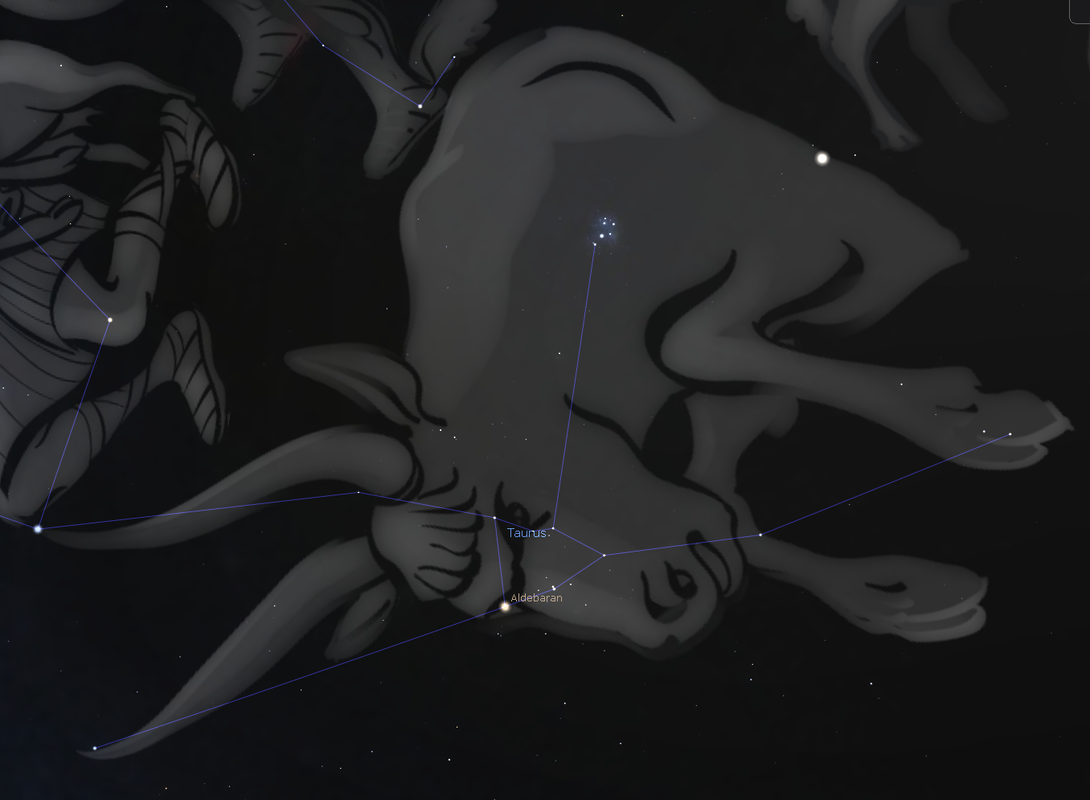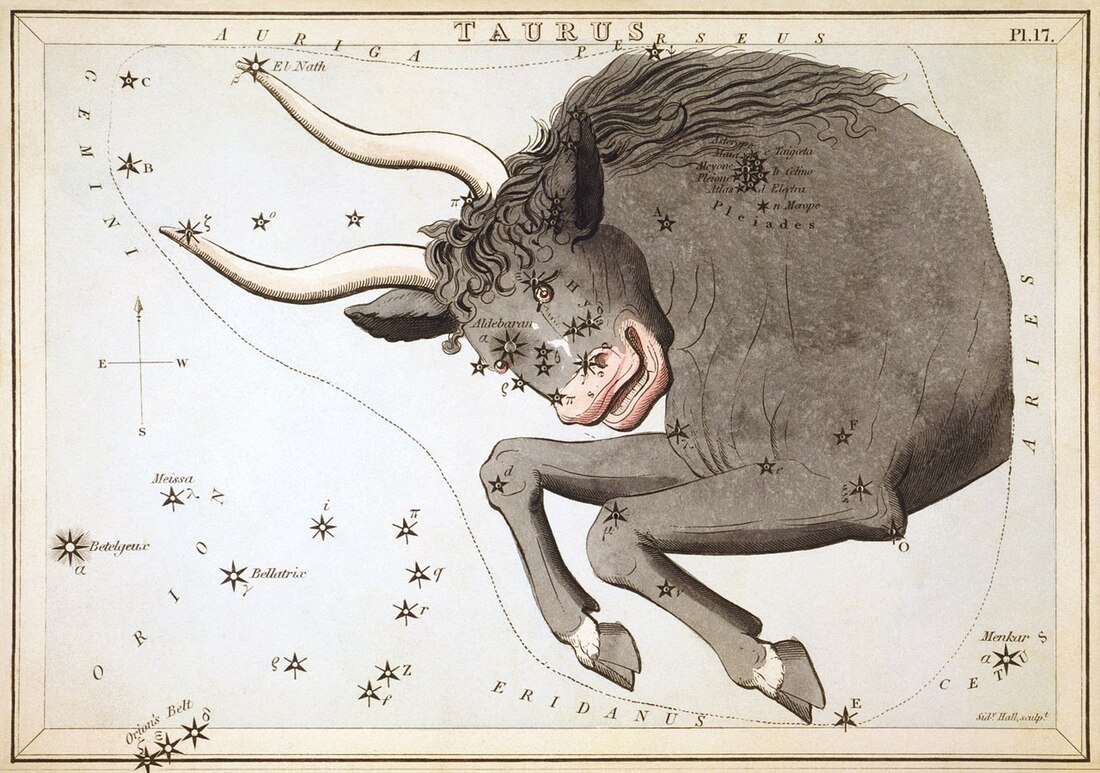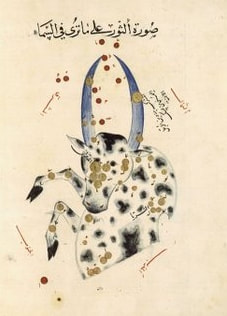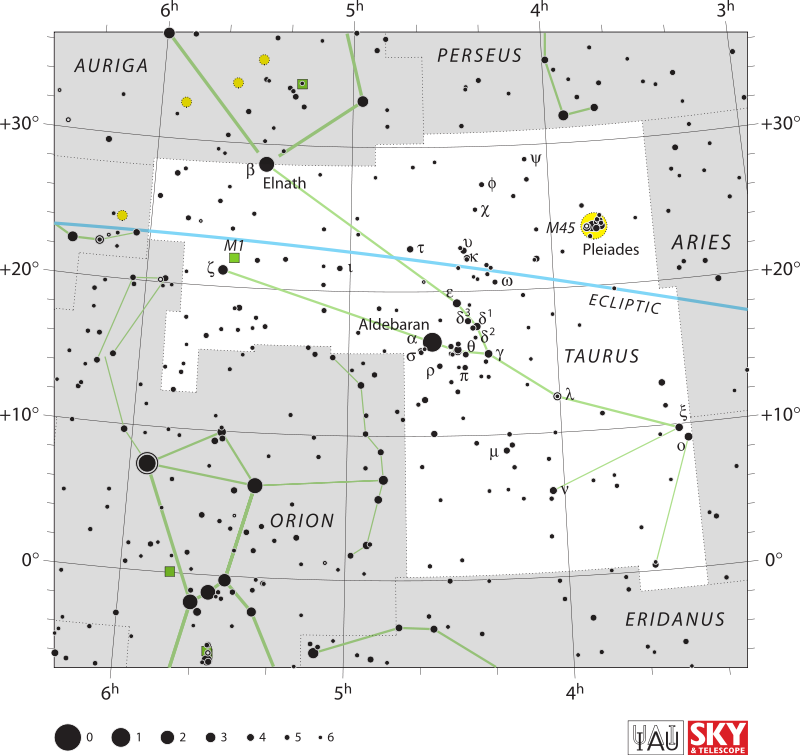|
One of the zodiac constellations, Taurus, or "the Bull" in Latin, is situated in the northern celestial hemisphere. During the winter months in the Northern Hemisphere, Taurus is a sizable and noticeable constellation. One of the oldest constellations, it indicated the location of the Sun during the spring equinox at least as far back as the Early Bronze Age. The many bull characters in the myths of Ancient Sumer, Akkad, Assyria, Babylon, Egypt, Greece, and Rome were impacted by their significance to the agricultural calendar. Taurus is an ancient astronomical symbol. , which resembles the head of a bull.
Astronomers are interested in a variety of aspects. The Pleiades and the Hyades, two open clusters that may be seen with the unaided eye, are in Taurus. The red giant star Aldebaran is the brightest star in the constellation at first magnitude. Messier 1, a pulsar-containing supernova remnant better known as the Crab Nebula, is in the northeastern region of Taurus. The Taurus-Auriga complex, one of the nearby active star-forming areas, enters the northern portion of the constellation. The pre-main-sequence star class has its prototype in the variable star T Tauri. |
Characteristics
Between Aries to the west and Gemini to the east, Taurus is a huge and noticeable constellation in the northern hemisphere's winter sky. To the north are Perseus and Auriga, to the southeast is Orion, to the south is Eridanus, and to the southwest is Cetus. When Taurus approaches opposition (its furthest point from the Sun) in late November or early December, it is fully visible throughout the night. It begins setting at sunset around the end of March and completely vanishes behind the Sun's brilliance from May through July. (Garfinkle 1997)
The ecliptic cuts through this constellation since it is a part of the zodiac. The apparent path of the Sun as the Earth completes its yearly orbit is formed by this circle across the celestial sphere. The Moon and the planets can be seen in Taurus at some point during the year since their orbital planes are close to the ecliptic. (Garfinkle 1997) The Milky Way's galactic plane crosses the constellation's north-eastern quadrant, and the anti-centre of the galaxy is close to the line separating Taurus and Auriga. The ecliptic, celestial equator, and galactic equator all pass through the constellation of Taurus. The constellation is traversed by the Gould's Belt, a ring-shaped cosmic structure. (Crossen & Rhemann 2004)
The International Astronomical Union chose "Tau" as the standard three-letter abbreviation for the constellation in 1922. (Russell 1922) A 26-segment polygon serves as the formal definition of the constellation borders, which Belgian astronomer Eugène Delporte established in 1930. These borders' right ascension values in the equatorial coordinate system range from 03h 23.4m to 05h 53.3m, while their declination coordinates fall between 31.10° and 1.35°. This constellation cannot be entirely circumpolar at any latitude since a little portion of it sits south of the celestial equator. (Seeds 2007)
Between Aries to the west and Gemini to the east, Taurus is a huge and noticeable constellation in the northern hemisphere's winter sky. To the north are Perseus and Auriga, to the southeast is Orion, to the south is Eridanus, and to the southwest is Cetus. When Taurus approaches opposition (its furthest point from the Sun) in late November or early December, it is fully visible throughout the night. It begins setting at sunset around the end of March and completely vanishes behind the Sun's brilliance from May through July. (Garfinkle 1997)
The ecliptic cuts through this constellation since it is a part of the zodiac. The apparent path of the Sun as the Earth completes its yearly orbit is formed by this circle across the celestial sphere. The Moon and the planets can be seen in Taurus at some point during the year since their orbital planes are close to the ecliptic. (Garfinkle 1997) The Milky Way's galactic plane crosses the constellation's north-eastern quadrant, and the anti-centre of the galaxy is close to the line separating Taurus and Auriga. The ecliptic, celestial equator, and galactic equator all pass through the constellation of Taurus. The constellation is traversed by the Gould's Belt, a ring-shaped cosmic structure. (Crossen & Rhemann 2004)
The International Astronomical Union chose "Tau" as the standard three-letter abbreviation for the constellation in 1922. (Russell 1922) A 26-segment polygon serves as the formal definition of the constellation borders, which Belgian astronomer Eugène Delporte established in 1930. These borders' right ascension values in the equatorial coordinate system range from 03h 23.4m to 05h 53.3m, while their declination coordinates fall between 31.10° and 1.35°. This constellation cannot be entirely circumpolar at any latitude since a little portion of it sits south of the celestial equator. (Seeds 2007)
|
History and mythology The association of the constellation Taurus with a bull dates back an exceptionally long time—possibly as far back as the Upper Palaeolithic, at least in the Chalcolithic. According to Michael Rappenglück of the University of Munich, Taurus is depicted with a picture of the Pleiades in a cave painting at Lascaux's Hall of the Bulls that is thought to date from around 15,000 BC. (Whitehouse 2000) Many languages, including those of Indigenous peoples in Australia, North America, and Siberia, refer to the Pleiades as the "seven sisters." This implies that the term might originate from a widespread old source. (Brown 2008) From roughly 4000 BC to 1700 BC, Taurus, a constellation in the Chalcolithic and Early Bronze Age, was designated the vernal (spring) equinox point before moving into the nearby constellation Aries. (Noonan 2005) At the spring equinox, in the late 23rd century BC, the Pleiades were at their closest to the Sun. The constellation was referred to in ancient Babylonian astrology as GU4.AN.NA, "The Bull of Heaven," in the MUL.APIN. The MUL.APIN tablets are said to show (Rogers 1998) that the vernal equinox was indicated by the Babylonian constellation known as "the hired man," despite claims that "when the Babylonians initially set up their zodiac, the vernal equinox lay in Taurus" (the modern Aries). (Harter 1965) |
|
The goddess Ishtar sends Taurus, the Bull of Heaven, to murder Gilgamesh in the Old Babylonian Epic of Gilgamesh after he rejected her advances. (Hines 2002) The quarters of the bull are severed off by Enkidu and thrown into the sky, where they are later recognised as the stars Ursa Major and Ursa Minor. Others associate Gilgamesh with the sun, whose rise on the equinox defeats the constellation, while others see him as the constellation of Orion's neighbour Taurus. The Sumerian goddess of sexual love, fertility, and war, Inanna, was closely identified with the Bull of Heaven in early Mesopotamian art. The bull is shown standing in front of the goddess' standard in one of the earliest representations; given that it has three stars (the cuneiform symbol for "star-constellation") depicted on its back, there is good reason to believe that this is the constellation that would later come to be known as Taurus. (White 2008)
|
The Dendera zodiac, an Egyptian bas-relief sculpture on a ceiling that represented the celestial hemisphere using a planisphere, featured the same iconic representation of the Heavenly Bull. These prehistoric cultures depicted the direction of the horns as either upward or backward. The horns in the later Greek representation pointed forward, which was different from this. (Rogers 1998) The constellation Taurus represented a sacred bull to the Egyptians, who connected it to the springtime rebirth of life. The constellation of Taurus would be obscured by the Sun in the western sky as spring began when the equinox entered Taurus. The earth was renewed because of this "sacrifice." Ptak 1998) Since Taurus was the first constellation in the early Hebrews' zodiac, Aleph, the first letter of their alphabet, was used to represent Taurus. (Allen 1963)
The position of the Sun on June 21, 1990, the first day of summer, crossed the IAU boundary from Gemini into Taurus because of the equinoxes' precession. Up until about 2600 AD, when it will be in Aries on the first day of summer, the Sun will progressively migrate through Taurus at a rate of 1° east every 72 years.
In Greek mythology, Zeus, who took the shape of a majestic white bull to kidnap Europa, a fabled Phoenician princess, was associated with Taurus. Only the front part of this constellation is shown in depictions of Greek mythology; this was sometimes interpreted as Taurus being partially submerged as he carried Europa out to sea. Taurus is portrayed as Io, a lover of Zeus, in a second Greek tale. Zeus transformed Io into a cow to conceal his lover from his wife Hera. (Ridpath 2018) Acusilaus, a Greek mythographer, attributes the Cretan Bull myth, one of Heracles' Twelve Labours, to the Taurus bull. (Stern 1996)
The Druids developed a significant cult of Taurus. They celebrated their religion with the Sun's transit of the Taurus constellation. (Noonan 2005) The constellation Sakiattiat and the Hyades are known as Nanurjuk and Sakiattiat, respectively, among the Inuit, an Arctic tribe. The latter is said to represent the spirit of the polar bear. The other stars in the Hyades are the dogs containing the beast, while Aldebaran stands in for the bear. (Penparse 2010)
According to Buddhist mythology, the Buddha was born when the full moon was in the sign of Taurus, Vaisakha. (Grünwedel 1901) The Wesak Festival, also known as Veskha, which takes place on the first or second full moon when the Sun is in Taurus, commemorates the birth of the Buddha.
The position of the Sun on June 21, 1990, the first day of summer, crossed the IAU boundary from Gemini into Taurus because of the equinoxes' precession. Up until about 2600 AD, when it will be in Aries on the first day of summer, the Sun will progressively migrate through Taurus at a rate of 1° east every 72 years.
In Greek mythology, Zeus, who took the shape of a majestic white bull to kidnap Europa, a fabled Phoenician princess, was associated with Taurus. Only the front part of this constellation is shown in depictions of Greek mythology; this was sometimes interpreted as Taurus being partially submerged as he carried Europa out to sea. Taurus is portrayed as Io, a lover of Zeus, in a second Greek tale. Zeus transformed Io into a cow to conceal his lover from his wife Hera. (Ridpath 2018) Acusilaus, a Greek mythographer, attributes the Cretan Bull myth, one of Heracles' Twelve Labours, to the Taurus bull. (Stern 1996)
The Druids developed a significant cult of Taurus. They celebrated their religion with the Sun's transit of the Taurus constellation. (Noonan 2005) The constellation Sakiattiat and the Hyades are known as Nanurjuk and Sakiattiat, respectively, among the Inuit, an Arctic tribe. The latter is said to represent the spirit of the polar bear. The other stars in the Hyades are the dogs containing the beast, while Aldebaran stands in for the bear. (Penparse 2010)
According to Buddhist mythology, the Buddha was born when the full moon was in the sign of Taurus, Vaisakha. (Grünwedel 1901) The Wesak Festival, also known as Veskha, which takes place on the first or second full moon when the Sun is in Taurus, commemorates the birth of the Buddha.
Deep-sky Objects
Main stars - 19
Bayer stars - 132
Stars with planets - Potentially 9
Stars brighter than magnitude 3.00 - 4
Stars within 32Ly - 1
Messier objects - 2
Meteor showers
Bordering
constellations
- NGC 1514 – Planetary Nebula
- NGC 1647 – Open Cluster
- NGC 1746 – (Previously an Open Cluster) Asterism
- NGC 1817 – Open Cluster
- NGC 1555 – Variable Reflection Nebula
- Messier 1 (M1) – Crab Nebula – Supernova Remnant
- Messier 45 (M45) - Pleiades - Open Cluster featuring reflection nebulosity
Main stars - 19
Bayer stars - 132
Stars with planets - Potentially 9
Stars brighter than magnitude 3.00 - 4
Stars within 32Ly - 1
Messier objects - 2
Meteor showers
- Taurids
- Beta Taurids
Bordering
constellations
- Auriga
- Perseus
- Aries
- Cetus
- Eridanus
- Orion
- Gemini



